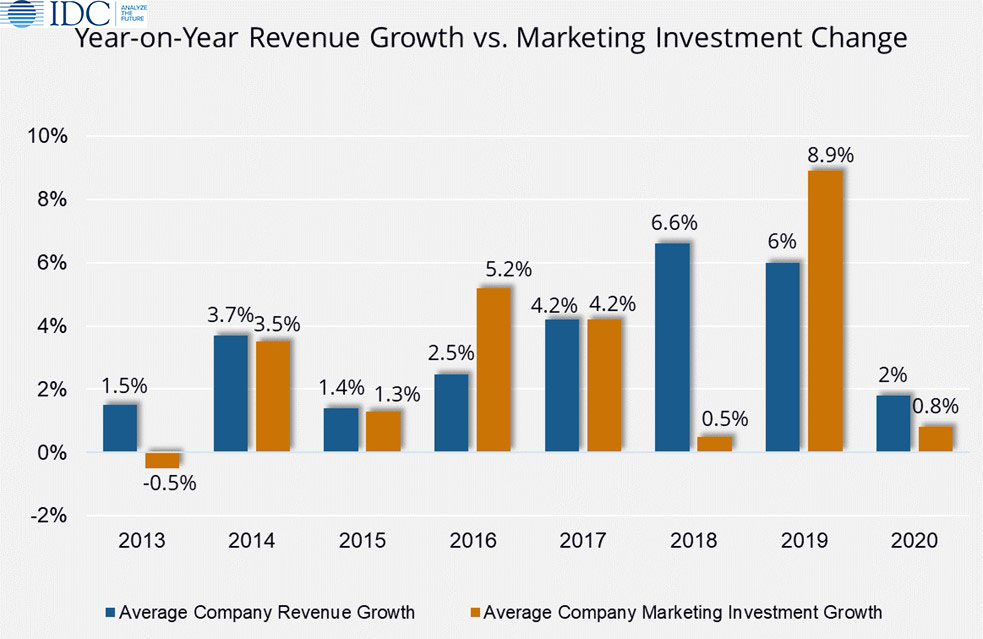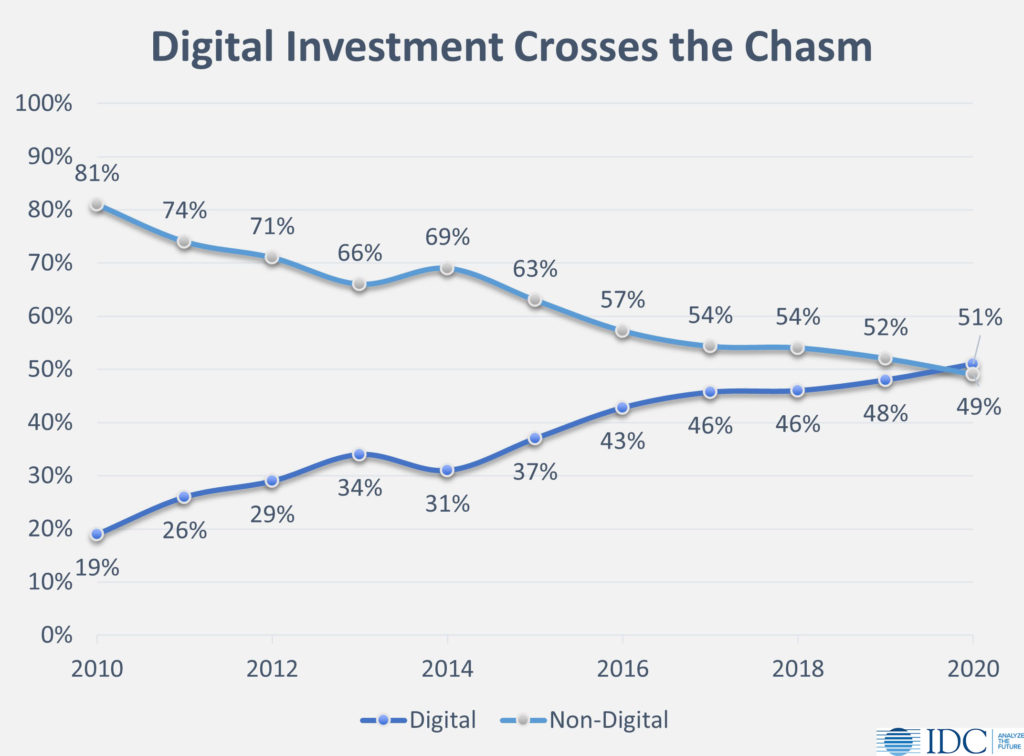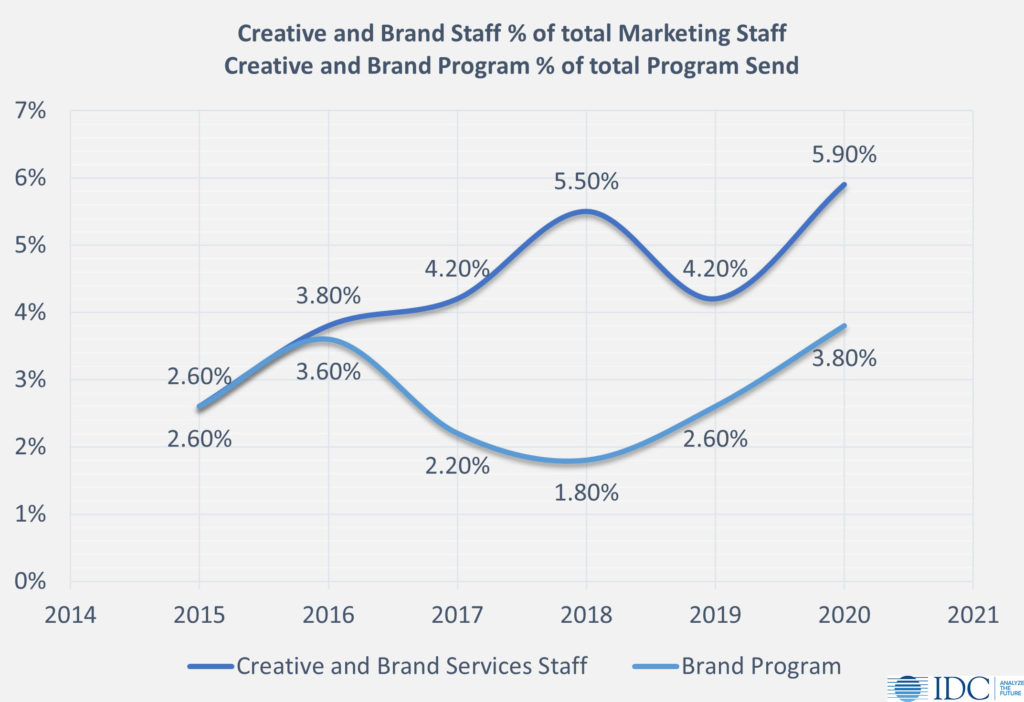IDC CMO Advisory Service has published results from its 18th annual Tech Marketing Investment Benchmark survey. Investment patterns provide evidence the impact COVID-19 has had on marketing’s investments. Technology buyers now use marketing-related information sources (digital and social) over sales at every stage of their decision-journey, according to IDC’s IT Buyer Experience survey.
It’s no longer enough to simply use digital to conduct traditional marketing better. IDC finds that marketing is shouldering pipeline building tasks that used to be in sales and moving into post-purchase realms to affect overall customer experience.
Impact from COVID-19
Marketing budgets among the 51 technology companies surveyed increase by an average of 0.8% in 2020. Those same companies also expect a revenue increase of 2% for the same period. IDC’s finding shows that the pandemic is impacting marketing departments, with a drop from last year. Out of the companies surveyed, 44% of companies grew their marketing budgets while 42% cut budgets and 14% stayed even.
In 2020, the average tech company’s marketing budget is 2.1% of revenue. However, this percentage varies by company size, sector, sales model, and growth. For example, software companies with greater than 50% of revenue from cloud have an average market budget ratio (MBR) of 6.7%, a slight increase from 4.9% last year. All benchmarks in this document are developed using a weighted average.

Digital Investment Crosses the Chasm
Over the past decade, tech buyers have trended sharply upward toward a preference for engaging digitally and with ecommerce. Now, the disruption caused by the pandemic has forced companies to roll two years’ worth of digital transformation into a compressed timeline. For the first time, digital spend is at 51%, surpassing non-digital investment (see Figure 3). Companies are making investments to shore up marketing technology, integrate data and analytics, and add digital skill sets. IDC doesn’t believe the shift in digital investment is temporary. The next normal has digital moving from a siloed vertical capability into a horizontal core competency.

Creative and Brand Services Get a Big Boost
Marketing is in the spotlight for managing brands’ response to the pandemic, addressing their position on social justice issues, and creating brand awareness and preference. As a result, total investment on brand efforts is at a five-year high. Corporations need more brand awareness through their online digital presence, promotions, and advertising. There has been an infusion of creative digital brand assets to reach customers where they are and address several substantive issues.
From 2015 to 2020, brand program spending increased 35.7% despite a significant drop from 2016 to 2018. During the same five-year time frame, staff spending grew 126.92%. Hardware and software companies have a larger percentage of creative and brand staff than their software and cloud counterparts. On the flipside, software and cloud providers invest more in brand identity.

Essential Guidance
For 2021 planning, IDC’s CMO Advisory Service analysts recommend a stronger focus on the following areas:
- Show your brand’s human side: Customers’ and consumers’ behavior increasingly shows that brand loyalty is on shaky ground. Customers no longer make buying decisions solely on the merits of your product portfolio. Customers are increasingly looking at how you treat your employees, respond to crisis, and walk the talk on your social responsibility positions. Customers want brands to reach out in empathetic and helpful ways. Now more than ever, customers want brands that act trustworthy and care about their customer’s experience. They want brands to show them their human side.
- Mature your digital capabilities: It is time to release digital from a vertical box and move it into a horizontal capability running across all marketing programming. Digital will become an always-on layer of engagement and experience for customers. Reimagine your programs to adjust to a blend of digital and physical worlds. Integrate and connect your customer data to orchestrate personalized brand moments. Build new skill sets in user experience (UX), digital experience, digital content creation, production, and data operations.
- Build resiliency and adaptability: How do you find success in a business, global health, and a societal climate of constant, unpredictable change? You avoid traditional, outdated approaches to managing and operating your business. It is time to plan, organize, and resource to best respond to acceleration. Adopting an agile mindset is critical to the path forward in a world with increasing volatility, uncertainty, complexity, and ambiguity. An agile mindset is a revisioning of your organization’s work into a constant flow, with shorter bursts of focus concentrated on efforts, testing, learning, and quickly adjusting priorities. Your mantra becomes “fast beats perfect” as you break down siloed walls, embrace collaborative leadership, and build connective tissue across customer-related functions. Success is measured by outcomes versus output.
The executive summary of the IDC Tech Marketing 2020 Benchmark survey is available to all IDC clients. For information about obtaining the full survey report or a custom analysis comparing your company to a group of your peers, please contact your IDC account manager or Warren Lane wlane@idc.com.
Want to learn more about the ways that IDC can assist in brand elevation, awareness, and demand generation efforts on your emerging technology’s journey to digital resiliency? Check out our new Accelerator Program:




